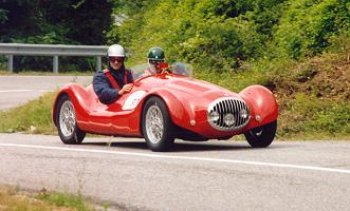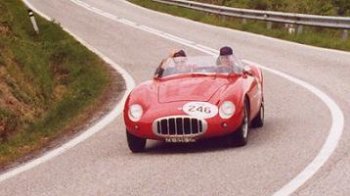
 |
The Tour Auto Lissac, which seeks to
recreate the magic of the Tour de France,
will honour the OSCA marque this year, half
a century after its epic giant killing
performances on the historic. Photos: The
OSCA MT4 has been a regular feature in the
Mille Miglia in recent years. |
|
|
|
The famous
historic OSCA marque is being honoured during this year's
Tour Auto Lissac. These small roadsters famously stamped their
name the
record books of the Tour
de France Automobile in the early 1950s.
The Tour Auto Lissac,
which seeks to recreate the magic of the Tour de France in
the modern era, this
year will take in a route from
Paris to Marseille spread over five days and covering
1,800 kilometres. No less than seven of these impressive little Italian
machines are on the final entry list.
Little known by the public at large,
"l’Officine Specializzate Costruzioni
Automobili" (OSCA) was founded in 1947 by the Maserati brothers,
ten years after the sale by the Maseratis of the marque that
carried
their name. Lightweight, agile and quick, the OSCAs made
European rally competition their domain of predilection.
Perhaps the finest victory came on the 1953 Tour de France
Automobile when Peron/Bertramier used the MT4's little
1-litre engine to success when pitted up against the mighty
3-litre Gordini of Jean Behra. The Tour Auto Lissac can this
year thus be proud to count
seven entered OSCAs, including two 1949 MT4s in the starting
list. The MT4 Vignale berlinetta of Craig Davis will be
making its return, more than 50 years after its
participations in the Tour de France. In the hands of d'Armengaud it
took part in the
1953 and 1954 editions, finishing a remarkable 4th place
overall in ’54. Another OSCA will be present in the
competition section, driven by Sir Stirling Moss himself.
These
extremely rare machines will be on public display under the
dome of
the Grand Palais from April 13, part of the 220 car entry, brought together at the Grand Palais
which will
constitute
the most extraordinary collection of sport and racing
automobiles open to the public, but also the most fleeting.
A rare
opportunity to come in close contact with legends of motor
racing including evocative lines that are normally only
seen
in colour glossy automobile magazines, cars such as the
Ferrari 250 GT, Ford GT 40, Lamborghini Miura and Maserati
A6 GCS.
OSCA: 20 memorable years of small
cylinders
The first OSCA ever was born in
1947 and 450kg linked to 71HP endowed it with stunning
performance. In 1962, the Maserati Brothers sold the
company to MV-Augusta, which ran a motorbike
business. The Oscas were then manufactured until
1967, with the same chassis basis; the top-of-the
range models being equipped with a Ford Germany V4,
1L7-engine. Sadly, this was the end of a glorious
era.
The two thirds of the cars
produced by OSCA at the time were designed for
motor-racing. Indeed, half of the 200 cars built by
OSCA, or nearly were MT4s. Up today we can list
about 85 MT4s offering various open or closed
versions. This car was for sure OSCA's most
successful one, making up for the F2, and even F1
disappointments. It was driven by numerous famous
racing drivers; even triumphant in 1954 winning the
12H of Sebring with legendary Stirling Moss, a Tour
Auto Lissac regular. From 1952 to 1954, the "Tour de
France Automobile" saw the tiny car challenging the
big cylinders, with a more than satisfying success.
1952: 3 OSCAs
entered. The MT4 Berlinette 1350cc (Armengaud-Chaix) comes
4th overall, whilst Peron couple's one ranks 3rd in class.
1953: 3 OSCAs
entered. The MT4 Spider 1100cc (Peron/Bertramier) wins the
overall classification, beating Jean Behra's 3000cc Gordini.
1954 :8 OSCAs
entered, including a rare MT4 2L at the hands of Louis
Chiron & Robert Delpech, while Alfonso de Portago drove a
Spider. Those two did not finish, leaving the MT4's
highest-placed feat to Peron/Bertramier, finishing 2nd in
class & 3rd overall.
|